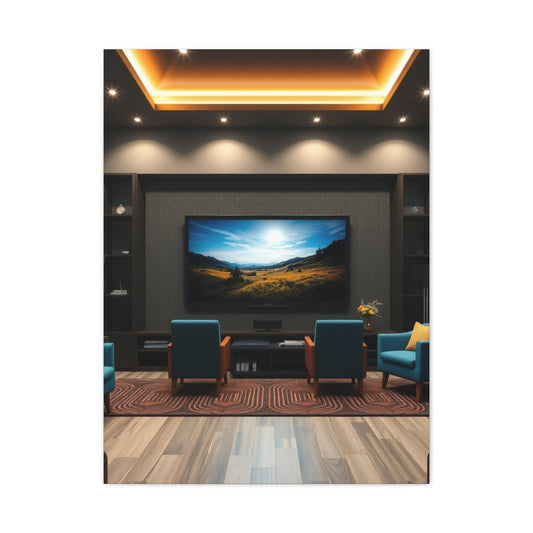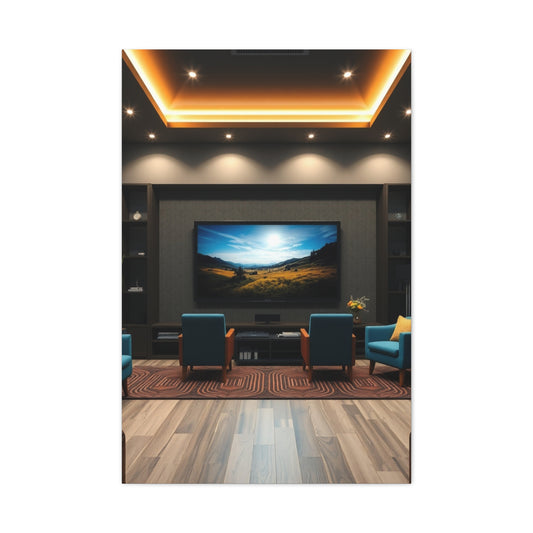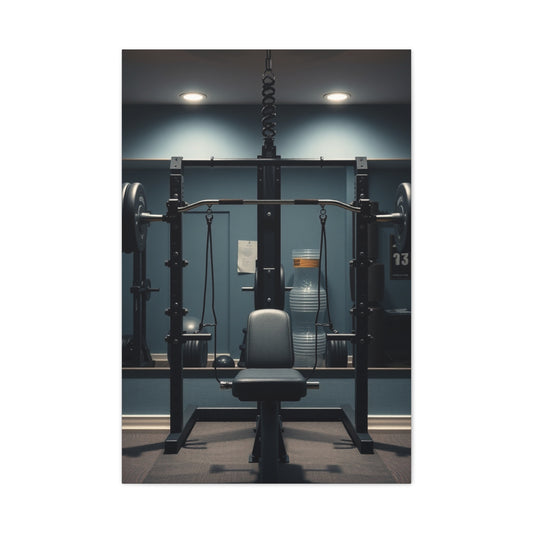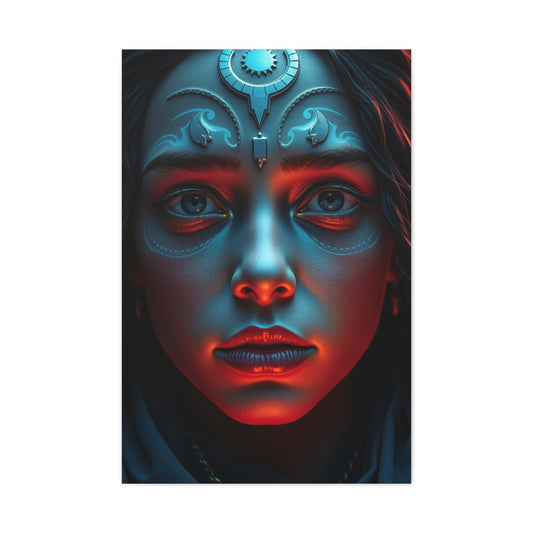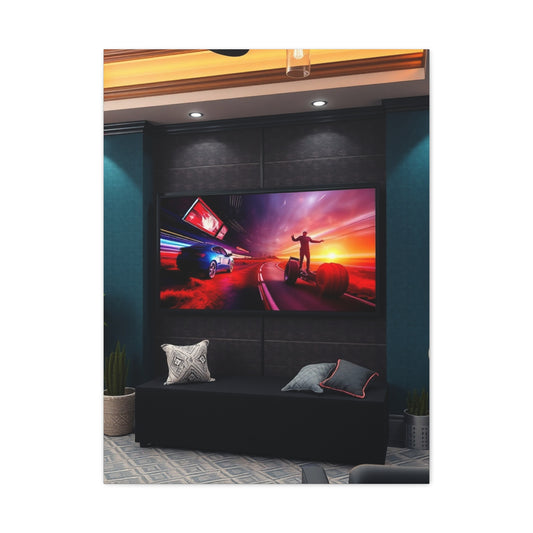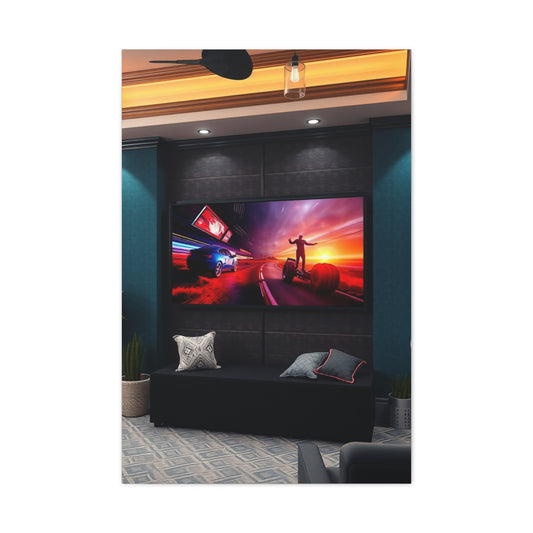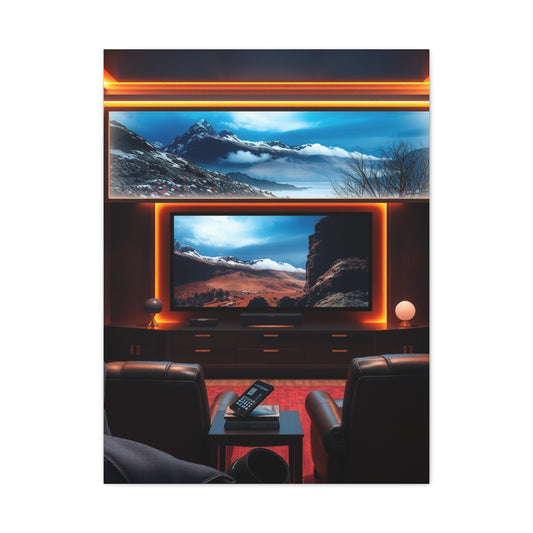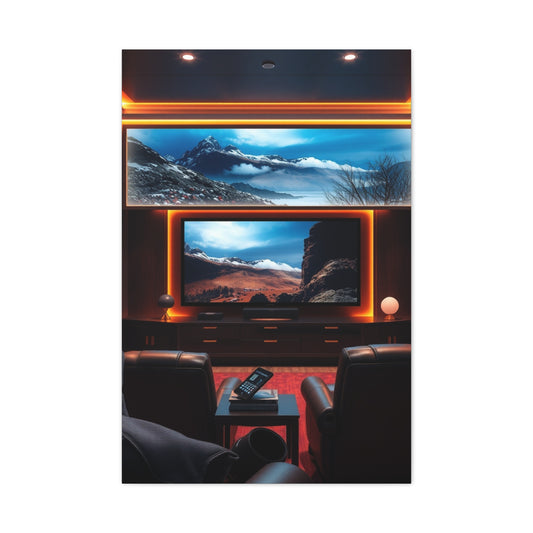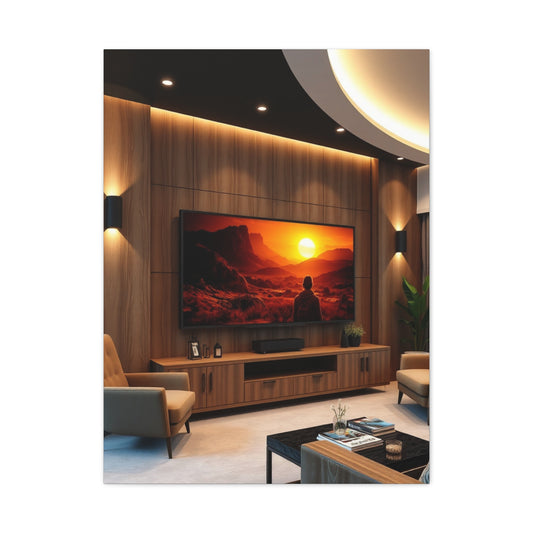Decorating your home is one of the most exciting ways to express yourself. The walls of your space, whether it’s a studio apartment, a family living room, or a cozy bedroom, are like a blank canvas waiting to be transformed. Yet, many people hesitate when it comes to picking wall art. The thought of searching through endless options, trying to match colors, deciding on sizes, and worrying about whether a piece will actually “fit” into their existing style can feel overwhelming. The truth is, choosing wall art does not have to be difficult at all. In fact, with the right mindset and approach, it can be an enjoyable and surprisingly simple process.
Overcoming the Intimidation Factor
The first challenge many face is intimidation. Art has long been treated as something mysterious or exclusive, reserved for galleries, collectors, or people with “an eye for design.” This perception alone can stop someone from confidently picking a piece. The reality, however, is that art in the home is deeply personal. There are no strict rules, only guidelines that help make the process smoother. The most important thing to remember is that your walls should reflect your personality, mood, and lifestyle. Once you start thinking about art as a reflection of who you are rather than a rigid design choice, the entire task becomes less daunting.
The Role of Personal Connection
One of the easiest ways to approach wall art is to focus on emotional connection rather than perfection. Instead of worrying whether a piece is trendy or fits some arbitrary design standard, ask yourself how it makes you feel. Does it calm you? Energize you? Remind you of a cherished memory? That feeling is what truly matters, and when you rely on it, decisions become quicker and more satisfying.
For instance, imagine standing in front of a print that showcases a serene ocean scene. If you’ve always loved the water, or it reminds you of a favorite vacation, that emotional pull is enough to justify it as the right piece for your home. This makes the process much more intuitive—you don’t need to second-guess yourself when the art resonates.
Simplifying with Layouts
Another factor that often confuses people is layout. Should you buy one large piece for a wall? A collection of smaller ones? A multi-panel arrangement? Thinking about layout can seem complicated, but in reality, it’s a helpful tool to make decisions easier. Layouts give structure to your creativity.
Start with the wall itself:
-
Small walls often look best with one statement piece or a vertically oriented design.
-
Medium-sized walls can benefit from two or three pieces arranged in balance.
-
Large walls open up the possibility of multi-panel art or a gallery-style arrangement.
Layouts can act like a roadmap, showing you how to organize your choices rather than leaving you lost in endless possibilities. Instead of feeling overwhelmed, you’re guided toward what works best for your space.
The Magic of Color Filtering
If there’s one feature that instantly makes selecting art easier, it’s the use of color. Color influences not only the look of a room but also how you feel within it. When choosing wall art, think about your existing décor. What shades dominate your furniture, curtains, or rugs? Do you want your art to blend seamlessly or stand out as a bold accent?
Breaking it down into simple categories can help:
-
Complementary colors (opposites on the color wheel) create contrast and make the artwork pop.
-
Analogous colors (neighboring hues) create harmony and softness.
-
Neutral tones (like grays, whites, and beiges) bring balance and calm.
By narrowing your choices based on color, you save time and avoid the stress of endless browsing. The decision becomes less about “what works” in a broad sense and more about “what works with my space.”
Seeing It in Your Room
Perhaps the hardest part of buying wall art has always been visualizing it in your own home. You might love a painting online or in a store, but will it actually look good above your couch or bed? This challenge has become much easier with the growing popularity of room previews. Even without special tools, you can train yourself to imagine scale and proportion.
Here’s a quick mental trick:
-
Use painter’s tape to mark the dimensions of the art you’re considering on your wall.
-
Step back and look at the outline in relation to your furniture.
-
If the outline feels balanced, the artwork in that size will likely work.
By taking this simple step, you remove guesswork and increase confidence in your decision. Visualization is a bridge between imagination and reality, making art selection far less uncertain.
Time and Simplicity
A surprising truth is that choosing wall art doesn’t have to take weeks of searching. In fact, most people, once they focus on their preferences, can make a decision quickly. The hesitation often comes from overthinking. Instead of worrying about every possible option, start narrowing down step by step—by layout, color, size, and emotional connection. This methodical process ensures you’re not sifting through irrelevant choices.
Many find that once they start filtering their preferences, they can find the perfect piece in less than an hour. That’s not because they rushed, but because they allowed themselves to trust the process.
Understanding Shopping Behavior
When people shop for art, patterns emerge. Some individuals browse endlessly because they enjoy the exploration, while others prefer to make quick decisions. Recognizing your own shopping style can make the experience smoother. If you’re someone who likes to take time, embrace the browsing stage without guilt. If you prefer efficiency, lean on filtering tools to speed things along. Neither approach is wrong; what matters is choosing in a way that feels natural for you.
Beyond the Basics
While layout, color, and visualization are excellent starting points, other factors also make choosing wall art simple. Think about your style preferences—do you lean toward minimalism, rustic charm, or vibrant eclecticism? Consider your budget as well, since having a range in mind can help narrow choices. These extra layers of consideration act like shortcuts, guiding you straight to what’s most relevant to you.
Shifting the Mindset
Ultimately, the biggest secret to making wall art selection easy lies in shifting your mindset. Instead of treating it as a daunting task, see it as an opportunity for self-expression. Your home should make you feel comfortable and inspired, and the art you select plays a major role in that. Once you approach the process with excitement rather than pressure, it transforms into an enjoyable journey rather than a stressful chore.
Decorating with wall art is much more than simply filling empty walls. It’s about creating an environment that feels complete, welcoming, and in harmony with your lifestyle. While the first step is realizing that selecting art isn’t as intimidating as it seems, the second step is learning how to work with your space effectively. Once you understand balance, proportion, and the mood-setting power of art, you’ll find that every decision becomes clearer and more rewarding.
The Role of Space in Wall Art Selection
The size and layout of your walls should always be the foundation of your choices. Too often, people buy art without considering the wall it will live on, and the result is a piece that feels lost or overpowering. The space itself is just as important as the artwork, and when the two work together, the effect is transformative.
A small wall in a hallway, for example, doesn’t need a large canvas. Instead, a modestly sized piece or a vertical arrangement of two or three smaller works can highlight the space without overwhelming it. On the other hand, a large blank wall in a living room or above a bed benefits from a bigger statement piece or multiple artworks arranged to create rhythm and flow.
By assessing your space first, you automatically narrow down your choices and save yourself the stress of wondering whether a piece will feel “right” once it arrives.
Balance and Proportion: The Hidden Keys to Harmony
One of the most overlooked aspects of wall art is proportion. Even the most beautiful piece can feel out of place if its scale doesn’t match the furniture or the room itself. Proportion ensures that your artwork contributes to harmony rather than creating visual tension.
A helpful rule of thumb is that artwork above a sofa or bed should be roughly two-thirds to three-quarters the width of the furniture beneath it. This balance anchors the piece to the furniture and prevents it from appearing too small or too large.
Height matters as well. Art should generally be hung so that its center is at eye level. In rooms with higher ceilings, you may adjust slightly upward, but the goal is to create a natural line of sight. When pieces are hung too high, they feel disconnected from the room; too low, and they can make the space feel heavy.
Think of balance as the invisible thread tying your art and furniture together. Once you understand it, you’ll notice how much easier it is to pick the right piece.
The Emotional Power of Mood
Wall art doesn’t just decorate a room; it sets the mood. Imagine walking into a dining area where the walls display bold, energetic abstracts in reds and oranges. The space instantly feels lively, stimulating conversation and energy. Now picture the same room with muted landscapes in cool blues and greens—the mood shifts toward calm, relaxation, and intimacy.
When choosing art, it helps to ask what kind of atmosphere you want a room to carry. Bedrooms often benefit from calming, soft-toned art that encourages rest. Living rooms, depending on how they’re used, might lean toward either dynamic energy or welcoming warmth. Home offices may call for art that motivates, while entryways often set the tone with art that feels inviting.
By aligning artwork with mood, you take much of the guesswork out of the process. You’re not simply picking based on aesthetics—you’re curating an emotional experience.
The Language of Style
Art also communicates style, which in turn reinforces the character of a home. Understanding style can simplify your choices, since you’ll gravitate toward certain types of art that naturally match your personality.
Some broad categories include:
-
Minimalist: Clean lines, neutral palettes, and simplicity that reduce clutter and emphasize calm.
-
Rustic or Nature-Inspired: Organic shapes, earthy tones, and depictions of landscapes or botanicals that bring the outdoors inside.
-
Modern Abstract: Bold forms, vibrant colors, and interpretive shapes that create energy and intrigue.
-
Classic or Traditional: Portraits, still life, or timeless motifs that convey history and stability.
-
Eclectic: A mixture of different art styles, patterns, and textures that reflect individuality and playfulness.
Recognizing which style resonates with you makes the process much easier, as you can quickly eliminate what doesn’t fit and focus on what speaks to you.
Mixing and Matching with Confidence
A common misconception is that every piece of art in your home must match perfectly. In reality, variety often enhances the overall atmosphere. The key lies in mixing and matching with intention.
For example, you might combine black-and-white photography with colorful abstract prints, provided they share a common theme such as mood or subject matter. Another approach is to vary the sizes and shapes of frames while keeping the color palette cohesive.
Mixing doesn’t mean chaos—it means balance with diversity. When done thoughtfully, it creates a layered, interesting environment that feels both curated and personal.
The Practical Side of Choosing Sizes
Beyond proportion, size itself is a practical tool for guiding decisions. Larger pieces tend to act as focal points, while smaller ones work well in supporting roles. If you’re decorating a large wall, a single oversized piece creates drama and anchors the space. On the other hand, multiple smaller pieces can form a gallery wall, allowing for creativity and storytelling.
For those who struggle with visualization, here’s a simple strategy: cut out paper in the dimensions of the artwork you’re considering, tape it to the wall, and step back. This exercise makes it much easier to see whether the size feels right before committing.
Lighting and Its Influence on Art
One often-overlooked aspect of art selection is lighting. The way a room is lit dramatically changes how artwork appears. Natural light can enhance colors during the day, while warm indoor lighting may soften tones at night. If your space relies heavily on artificial light, consider how shadows and reflections might affect the look of glossy or glass-covered art.
Lighting doesn’t have to be complicated—simply being aware of its influence helps you choose pieces that will look good under different conditions. A bright, naturally lit room might invite bold colors, while a dimmer space may benefit from lighter, reflective tones that keep the room from feeling heavy.
Considering Longevity and Change
When choosing wall art, it’s also worth thinking about longevity. Some people prefer timeless pieces they’ll never tire of, while others enjoy rotating their art with the seasons or their mood. Neither approach is wrong, but knowing which you prefer can simplify decisions.
If you want long-term stability, choose pieces with classic themes or colors you’ve always loved. If you enjoy change, lean toward versatile art that can mix easily with other pieces when you decide to rearrange. This awareness takes away the fear of “what if I get tired of it?” and replaces it with a sense of control.
Art as a Reflection of Identity
Perhaps the most liberating idea is to see wall art as a mirror of your identity. Your home is a sanctuary, and the art within it tells a story about who you are. Whether you’re drawn to vibrant colors, serene landscapes, or striking modern compositions, these choices reflect your values, memories, and aspirations.
This perspective makes the process of choosing wall art less about pleasing others or following trends and more about celebrating yourself. Once you embrace this, decision-making feels less pressured and more joyful.
The Ease of Modern Options
While the process of picking art used to require physically visiting galleries and shops, today’s accessibility means you can explore styles, sizes, and moods at your own pace from home. The abundance of options, while initially overwhelming, is actually liberating once you apply the principles of space, balance, mood, and personal identity. With each filter—whether mental or practical—you bring yourself closer to the perfect match.
Every room in your home serves a different purpose. The living room is where people gather, the bedroom is your private retreat, the dining area is a place for conversation and connection, and the office may be where productivity thrives. Because each space carries its own personality and function, the wall art you choose should reflect and enhance those qualities. While the general principles of size, balance, and mood are universal, tailoring your artwork to the room itself makes your home feel cohesive and intentional.
The Living Room: The Heart of the Home
The living room is often the largest and most central space in a home, which makes it the perfect place to showcase your personality. This room sets the tone for your style, welcoming guests while also providing a space for relaxation.
When selecting wall art for the living room, think of it as the anchor of your home’s aesthetic. Because the living room tends to have more wall space, it allows for larger pieces or creative arrangements. A statement artwork above the sofa, for example, can tie the entire room together.
Consider how you use the space. If your living room is lively, filled with conversations and gatherings, bold and energetic artwork—such as abstracts, geometric designs, or vibrant landscapes—can match that energy. If it’s more of a sanctuary for quiet evenings, softer tones, serene imagery, or minimalist art may be more appropriate.
Gallery walls also work beautifully in living rooms. Combining different pieces in a thoughtful arrangement adds depth and tells a story, especially if you mix photography, paintings, and even small sculptural elements.
The Bedroom: A Place of Rest and Reflection
Unlike the social nature of a living room, the bedroom is deeply personal. It’s where you unwind at the end of the day and wake up to a new one. The art here should promote peace, comfort, and reflection rather than stimulation.
Calming imagery works best in this space. Landscapes, nature-inspired art, or abstract designs in muted tones help create a restful environment. Blues, greens, and neutrals are popular choices for their soothing qualities.
Placement is important too. Above the headboard is the most common location, and a horizontally oriented piece often complements the width of the bed. Alternatively, two or three smaller works arranged in balance can frame the headboard beautifully.
The bedroom is also a great place for personal art that holds special meaning—photographs, subtle portraits, or pieces that evoke cherished memories. Because it’s such a private space, you can lean into intimacy rather than thinking too much about trends or outside impressions.
The Dining Room: Creating Atmosphere for Connection
Dining areas are unique because they’re spaces of both activity and atmosphere. Meals are not only about food but also about conversation and shared experiences. Art here can set the tone for those interactions.
Warm, inviting colors often work best in dining rooms. Reds, oranges, and yellows can stimulate energy and appetite, while deeper tones create intimacy. Artwork that sparks conversation—abstracts, cultural themes, or pieces with intriguing details—can add depth to the room.
Since dining rooms often feature one dominant wall, a single medium-to-large piece works beautifully. For more formal dining spaces, symmetrical arrangements or paired artworks create balance and sophistication. For casual dining, playful or eclectic choices can keep the space feeling lively.
The Kitchen: Functional Yet Full of Character
Kitchens are primarily practical spaces, but that doesn’t mean they should be devoid of art. In fact, carefully chosen wall art can add personality to an otherwise functional area.
Because kitchens often have less open wall space, smaller artworks or prints work best. Themes tied to nature, food, or abstract simplicity tend to fit naturally here. Bright, cheerful colors can energize the space, while black-and-white art adds a clean, modern feel.
One common approach is to decorate above counters, breakfast nooks, or open shelving. These small touches make the kitchen feel less utilitarian and more like an extension of the home’s overall personality.
The Home Office: Productivity Meets Inspiration
As more people work from home, the home office has become an essential part of modern living. The art here should support productivity without overwhelming the senses.
Inspirational imagery—whether through abstract designs, landscapes that suggest growth, or typography that reinforces motivation—can be highly effective. Calming tones like blues and greens can reduce stress, while brighter accents like yellows or oranges can spark creativity.
Placement matters too. Art behind or adjacent to your desk can provide visual breaks during the day, preventing the room from feeling sterile. The goal is to create an environment that energizes without distracting, encouraging focus while still offering beauty.
The Entryway: First Impressions Matter
The entryway is the first space people see when they enter your home, which makes it the perfect opportunity to set the tone. Even if your entry is small, one carefully chosen artwork can make a powerful statement.
Because entryways often lack furniture, vertical pieces or bold single artworks can define the space. Themes that feel welcoming—abstracts with warm tones, nature-inspired imagery, or even minimalist pieces—help establish mood immediately.
This is also an excellent location for art that reflects your personality. Since it greets both you and your guests, it can act as an introduction to the rest of your home.
The Bathroom: Small Spaces with Big Potential
Bathrooms are often overlooked when it comes to wall art, yet they provide opportunities to add unexpected charm. Because these spaces are smaller, artwork here should be subtle but effective.
Smaller prints, simple line drawings, or pieces with water-related themes can feel natural in bathrooms. Coastal imagery, botanicals, or abstract splashes of color also work well. The key is to choose pieces that withstand humidity if they’re in direct contact with moisture.
Art in bathrooms doesn’t need to be serious—playful pieces can add personality and surprise in a place where guests may not expect it.
Children’s Rooms and Play Areas: Whimsy and Growth
Children’s rooms and play areas offer a chance to bring color, imagination, and whimsy into your art choices. Pieces with bright colors, playful themes, or educational elements can create a joyful environment while also supporting learning and creativity.
Framing art for children’s rooms allows you to rotate it as they grow, ensuring the space evolves with them. Simple gallery walls filled with their favorite themes—whether animals, space, or abstract shapes—can bring both fun and comfort.
Hallways and Transitional Spaces: The Unsung Heroes
Hallways, staircases, and transitional areas are often neglected, yet they provide the perfect canvas for art. Because these spaces connect different rooms, they act as visual bridges.
Long, narrow hallways benefit from a series of smaller artworks that guide the eye forward. Staircases work beautifully with vertical arrangements that follow the natural slope. These transitional spaces are excellent opportunities for storytelling—family photos, thematic series, or cohesive collections can make the journey through your home engaging.
Seasonal and Rotational Art
One unique approach to decorating every room is embracing seasonal or rotational art. Instead of treating art as permanent, you can refresh your walls with the changing seasons or even your own mood.
For example, light and airy pieces work beautifully in spring and summer, while deeper tones and textured works feel right in fall and winter. Rotating art keeps every room feeling fresh without the need for constant redecorating.
This strategy works particularly well in living rooms and entryways, where first impressions matter most. It allows you to enjoy different aspects of your taste throughout the year.
Personal Touches Across Every Room
Beyond style, color, and mood, personal touches bring meaning to wall art. Travel photography, local artists, or pieces tied to your culture or family history make your home truly yours. Every room provides opportunities for these stories. A dining room might feature a painting inspired by a memorable trip, while a bedroom could hold art that celebrates your personal journey.
These touches add depth that goes beyond design—they create an environment infused with memory and connection.
Wall art isn’t just decoration—it’s a lifelong companion that evolves with your personal journey. Just as people change over time, so too does the art that resonates with them. While earlier parts of this series explored how to simplify the process, understand balance, and tailor art to each room, this final section looks beyond the immediate task of choosing artwork. Instead, it considers the long-term vision: how to curate, layer, and grow a meaningful art collection that will remain satisfying for years to come.
The Difference Between Decorating and Curating
When people first begin selecting wall art, the focus is often on filling space. There’s nothing wrong with this approach—after all, bare walls can make a home feel incomplete. But over time, the goal can shift from simply decorating to thoughtfully curating.
Decorating is about making a space look good in the moment. Curating, on the other hand, is about building a narrative through art that reflects your personality, values, and evolving tastes. A curated collection doesn’t need to be expensive or highbrow. It simply means your choices are intentional, layered, and meaningful.
Letting Your Collection Grow Organically
One of the biggest misconceptions is that you need to fill your walls all at once. In reality, the most satisfying collections grow slowly. As you encounter pieces that resonate—whether in local shops, online platforms, or through personal creations—you can add them gradually. This allows your walls to tell a story that evolves with your life rather than appearing staged.
Think of art like a wardrobe. You don’t buy every piece of clothing you’ll ever wear in one shopping trip. Instead, you collect over time, adapting to seasons, moods, and new experiences. Similarly, art can be layered and rotated to reflect where you are in your journey.
|
Related Catagories: |
Balancing Trends with Timeless Choices
Design trends change quickly. One year, abstract minimalism might dominate, while the next, maximalist patterns may take center stage. It’s easy to be swept up by these shifts, but building a collection that lasts requires balance.
One strategy is to let trends influence smaller or more affordable pieces while investing more deeply in timeless themes you’ve always loved. For example, if you’ve always been drawn to nature, landscapes, and botanical art will remain relevant to you even as color palettes and design styles shift. Meanwhile, trendy geometric or neon prints can add a current flair without overwhelming your long-term vision.
This balance allows your walls to feel both contemporary and enduring. You stay connected to the present while also honoring what consistently resonates with you.
The Importance of Cohesion Across Spaces
As your art collection grows, cohesion becomes increasingly important. While each room can have its own character, a sense of connection between them prevents your home from feeling disjointed. Cohesion doesn’t mean every piece must match. Instead, it’s about creating subtle threads of continuity.
This could be achieved through:
-
A shared color palette running through multiple rooms.
-
Recurring themes such as nature, geometry, or cultural motifs.
-
Consistent framing styles that tie different artworks together.
Think of your home as a gallery. Each room has its own focus, but when you move between them, you should sense a larger story unfolding. This doesn’t happen by accident—it emerges when you’re intentional about linking pieces together.
Curating Around Focal Points
Not every piece of art needs to be a showstopper. In fact, a collection thrives on a balance between focal points and supporting works. A bold, oversized abstract might dominate a living room, while smaller complementary prints provide rhythm and context around it.
When curating, ask yourself which pieces you want to act as anchors in each room. Then, build around them with supporting artworks that add variety without competing for attention. This approach creates flow and prevents walls from feeling chaotic.
Embracing Variety Without Losing Direction
Variety keeps a collection interesting, but too much variety without direction can feel cluttered. The trick is to experiment with different media, subjects, and styles while still staying grounded in your identity.
For instance, mixing photography with paintings can add texture and contrast. Including both abstract and representational art can create dialogue between imagination and reality. Adding sculptural wall pieces or textile art can introduce dimension. As long as these elements tie back to your core themes—whether through color, mood, or personal meaning—they’ll feel cohesive rather than random.
The Role of Memory and Storytelling
Some of the most meaningful art pieces aren’t chosen for style at all but for the memories they represent. Travel photographs, prints from local artists you encountered on a trip, or handmade pieces from family and friends all carry emotional weight.
Integrating these personal works into your collection gives your walls depth beyond design. They become storytelling devices, sparking conversations and reminding you daily of your journey. Over time, these pieces may become more precious than any trend-driven artwork, anchoring your collection in memory and authenticity.
Adapting Art to Life’s Changes
As life shifts, so will your taste and needs. Moving into a new home, starting a family, or transitioning to a different stage of life can all influence the kind of art you gravitate toward. A curated collection isn’t static—it adapts with you.
Flexibility is key here. Modular gallery walls, easily changeable frames, and rotating displays allow you to adapt without needing to start over. Think of your art as a living collection rather than a fixed display. This mindset removes pressure and keeps the process enjoyable.
The Power of Rotation
One simple but powerful technique is rotating your art. Instead of hanging pieces permanently, consider switching them out seasonally or annually. This keeps your walls feeling fresh and allows you to enjoy different parts of your collection over time.
Rotation works especially well for those who enjoy experimenting with trends or for homes with limited wall space. Pieces stored safely can always make a reappearance, giving your home an ever-evolving gallery feel.
Curating with Budget in Mind
A lasting collection doesn’t need to be expensive. What matters is intentionality, not price. Many people mix affordable prints with a few investment pieces, creating a balance between accessibility and longevity.
Framing can also elevate even the simplest print, making it feel polished and intentional. Similarly, arranging multiple modest artworks into a thoughtful gallery wall can have just as much impact as a single high-cost piece.
By focusing on what resonates with you emotionally and aesthetically, you ensure your collection has value beyond cost.
The Role of Negative Space
While it’s tempting to fill every wall, negative space—the empty areas left intentionally blank—is just as important in curating a collection. Negative space gives your eyes room to rest and makes individual artworks stand out more.
A well-placed blank wall can feel as intentional as one filled with art. By balancing filled and unfilled spaces, you create rhythm and breathing room, enhancing the overall harmony of your home.
Curating Beyond Walls
Wall art is the centerpiece of a collection, but it doesn’t have to stop there. Sculptural pieces, ceramics, and textiles can complement your wall displays, blurring the line between decoration and art. Shelves can host small artworks that lean casually against walls, adding depth and dimension. By thinking of art as part of the entire room rather than just the wall, you create a holistic environment that feels cohesive and layered.
Trusting Your Intuition
Perhaps the most important long-term lesson in curating art is learning to trust your intuition. Guides and principles can help, but ultimately, your art should resonate with you. If a piece sparks joy, evokes memory, or stirs curiosity, that alone is reason enough to include it.
Over time, trusting your instincts will shape a collection that feels authentic rather than forced. This is the essence of curation—not following rules, but weaving together pieces that reflect your life and taste.
Art as a Lifelong Journey
The beauty of wall art lies in its ability to grow with you. What you love today may differ from what you love in ten years, and that’s perfectly natural. A curated collection isn’t about achieving a final destination but about enjoying the journey. Each piece you choose adds a new chapter to your story, creating a home that evolves alongside you.
Wall art does more than fill a blank wall. It sets the tone of a room, influences emotions, and communicates aspects of your personality to anyone who enters your space. The pieces you choose are silent storytellers, shaping both your internal environment and your external image. This section explores the deeper dimensions of wall art: how it affects mood, builds identity, creates connection, and transcends decoration to become part of your lived experience.
Art as Emotional Atmosphere
One of the most immediate effects of wall art is its ability to influence the atmosphere. Color, form, and subject all carry emotional weight. Think about stepping into a room with bold, fiery abstract strokes in shades of red and orange. The space feels energized, vibrant, even intense. Now picture a room filled with soft watercolor landscapes in blues and greens—it evokes calm, peace, and a sense of openness.
Choosing art, then, is less about “what looks good” and more about “what feels right.” Ask yourself: What emotion do I want this space to evoke?
-
For relaxation spaces like bedrooms or reading nooks, calming palettes and soothing imagery often work best.
-
For social spaces like dining or living rooms, energetic or conversation-starting pieces create liveliness.
-
For workspaces, motivational or thought-provoking art can spark creativity.
This emotional resonance is why art feels personal—it transforms not just your walls, but your state of mind.
Wall Art as an Extension of Identity
Your home is an external expression of who you are, and your art is one of the clearest windows into that identity. Guests can often learn a lot about a person simply by observing their walls.
-
A collection of travel photography suggests curiosity and adventure.
-
Minimalist abstract works hint at a preference for simplicity and structure.
-
Pop-art posters might show a playful or nostalgic personality.
-
Family portraits or handmade crafts communicate warmth and rootedness.
Unlike furniture, which is often chosen for functionality, art is chosen almost entirely for meaning. That’s why it acts as a form of self-expression—it reveals your tastes, values, and even aspirations.
The Subtle Language of Color
Color psychology plays a huge role in how art shapes perception. Beyond mood, colors also communicate cultural meaning and symbolism.
-
Blue often represents calm, trust, and introspection.
-
Red conveys passion, urgency, or strength.
-
Green suggests renewal, balance, and nature.
-
Yellow radiates optimism and creativity.
-
Black-and-white art emphasizes timelessness and sophistication.
These associations may vary across cultures, but universally, color guides how we interpret space. By intentionally choosing palettes, you can make subtle statements about how you want your home—and yourself—to be perceived.
Creating Shared Meaning in Homes
Art isn’t only about individual expression; it can also reflect shared identity. Couples, families, and even roommates often negotiate their wall art choices to represent the household as a whole.
A family might hang generational portraits, blending heritage with modern décor. A couple may choose a large canvas together, symbolizing a shared journey. Even in shared apartments, common areas often feature artwork that balances different personalities, creating harmony.
This collaborative curation transforms walls into a reflection of collective identity, where each piece carries meaning for multiple people, not just one.
Art as a Conversation Starter
One of the underestimated powers of wall art is its ability to spark dialogue. A striking or unusual piece can serve as an instant icebreaker when guests visit.
Abstracts often provoke interpretation: “What do you see in this?” Travel photography invites storytelling: “This was taken on our trip to Morocco.” Even humorous or quirky prints can create laughter and connection.
In this way, wall art becomes social—it fosters conversation and allows you to share parts of your personality without words.
The Therapeutic Value of Wall Art
Beyond aesthetics, art has therapeutic qualities. Psychologists and interior designers alike emphasize the connection between environment and well-being.
-
Stress reduction: Natural imagery, particularly water and greenery, has been shown to reduce stress.
-
Creativity boost: Abstract and colorful designs can stimulate imagination.
-
Healing: Many healthcare facilities use art intentionally to comfort patients.
At home, choosing art that nourishes your mental health is a form of self-care. It’s about creating surroundings that support emotional balance, not just visual appeal.
The Influence of Culture and Heritage
Wall art often connects us to culture—whether our own or others we admire. It can be a way of honoring heritage, exploring diversity, or celebrating tradition.
-
Indigenous artwork may carry deep symbolism tied to land and ancestry.
-
Calligraphy, mandalas, or folk motifs represent centuries of cultural artistry.
-
Global art pieces from travels reflect respect and curiosity for other cultures.
By integrating cultural art into your walls, you’re not just decorating—you’re participating in a dialogue between past and present, self and community.
Wall Art and Personal Growth
Interestingly, the art you choose often reflects where you are in life. In your early twenties, posters or inexpensive prints might dominate. As you grow, you may seek more original pieces, handmade crafts, or art that connects with deeper themes.
Your art collection becomes a timeline of your personal growth. Looking back at older pieces can remind you of who you were, while new acquisitions reflect who you are becoming. In this sense, your walls act like a diary—visual entries of different life chapters.
Minimalism vs. Maximalism in Self-Expression
Different philosophies of art curation reflect different approaches to self-expression.
-
Minimalist walls with one or two striking pieces suggest clarity, focus, and restraint.
-
Maximalist gallery walls bursting with variety suggest openness, energy, and a love for storytelling.
Neither approach is “better”—each simply mirrors personality. Some thrive in calm, sparse environments, while others feel most alive surrounded by layers of creativity. Choosing your style is ultimately choosing how you want to live.
The Role of Humor and Whimsy
Not all art needs to be serious. In fact, playful or humorous pieces can add joy to daily life. A quirky illustration, bold pop-art print, or funny typography can lighten the mood in a space.
Humor in art also reflects approachability. Guests often feel more relaxed when they encounter lighthearted touches, and homeowners enjoy the reminder that design doesn’t always need to be formal.
Wall Art and Memory-Making
Many people find joy in incorporating personal photos as part of their wall art. While some shy away from photography in favor of “real art,” the truth is that personal photos—when displayed thoughtfully—are powerful artworks in themselves.
A black-and-white gallery of family portraits, candid travel shots framed with intention, or even artistic edits of personal photography, elevates memory into art. These displays blur the line between personal and aesthetic, reminding us that the most meaningful walls often hold pieces of our own story.
Art as Investment—Financial and Emotional
Some see wall art as purely decorative, but for others, it’s also an investment. Original works from emerging artists can increase in financial value over time. But even when art doesn’t appreciate in monetary terms, it appreciates in emotional value.
That painting you bought from a street artist during a backpacking trip may never hang in a museum, but for you, it holds priceless meaning. Investments in art should therefore be understood broadly—as investments in beauty, memory, and personal identity.
Future-Proofing Your Walls
As technology evolves, so does the way we engage with art. Digital art frames that rotate collections, projection-based displays, and even interactive AR installations are increasingly popular. These innovations allow walls to change constantly, blending flexibility with creativity.
Yet, even in a digital future, physical wall art will remain powerful. The tactile presence of canvas, paper, or wood carries weight that screens cannot fully replicate. The future may bring a hybrid approach—static pieces balanced with dynamic, digital displays.
When Less Is More: Embracing Silence
Sometimes, the most powerful choice is restraint. A single commanding piece on an otherwise bare wall can create more impact than dozens of smaller works. Silence—or empty wall space—becomes part of the art itself.
This minimalist approach allows focus, prevents overstimulation, and highlights the significance of chosen works. It’s a reminder that wall art is as much about editing as it is about adding.
Wall art has always adapted to the times. From cave paintings to Renaissance frescoes, from 20th-century posters to today’s digital prints, the way we create and display art has continuously evolved. As lifestyles, technology, and environmental awareness reshape how we live, the role of wall art is changing, too. This final part explores where wall art is headed: the innovations, cultural shifts, and sustainability practices that are defining the future of decorating our walls.
The Rise of Digital Art and Tech Integration
One of the most striking shifts in recent years is the growing presence of digital art. No longer limited to galleries or niche collectors, digital works have become accessible through high-resolution displays and digital art frames.
Imagine owning a single screen that cycles through hundreds of curated artworks. Instead of committing to one static piece, you can refresh your walls seasonally, daily, or even hourly. Some digital art platforms even allow you to subscribe to rotating collections, giving your space continuous new energy.
Augmented reality (AR) is also transforming the buying process. Many apps now let you virtually “place” art on your walls through your phone’s camera. This removes uncertainty about scale and fit, making art selection more intuitive. For some, the AR experience itself feels almost like art—an immersive preview of how a space might feel.
Virtual reality (VR) extends this further. Art lovers can now explore galleries from across the world without leaving home, exposing them to styles and artists they might never have encountered otherwise. In the future, VR-based personalization might allow you to curate entire digital rooms, then translate those choices into physical purchases.
Sustainability in Wall Art
Environmental consciousness is reshaping every aspect of design, including wall art. As consumers grow more mindful of sustainability, artists and manufacturers are adopting eco-friendly practices.
-
Sustainable materials: Reclaimed wood, recycled paper, and bamboo canvases are increasingly common. These reduce waste and provide a unique texture that adds character.
-
Low-impact printing: Water-based inks and energy-efficient printing methods are becoming industry standards.
-
Local sourcing: Many buyers prefer supporting local artists to reduce the carbon footprint of shipping and to strengthen community ties.
Even the idea of minimalism, which emphasizes fewer but more meaningful pieces, aligns with sustainable values. Instead of filling walls with disposable décor, people are investing in fewer, lasting works that hold deeper meaning.
Personalization and Custom Art
Another defining trend of the future is personalization. People no longer want generic pieces that appear in countless homes—they want art that reflects their story.
Custom art allows individuals to collaborate with artists, creating pieces that capture personal memories, favorite places, or symbolic imagery. Digital tools make this process easier: you can upload photographs, share color palettes, or provide inspiration boards, and artists can adapt their work accordingly.
Generative design, powered by artificial intelligence, also plays a role. AI can create customized patterns, styles, and compositions based on personal preferences. This doesn’t replace human artistry but expands possibilities, blending human creativity with computational power.
The result? Every wall tells a story unique to the person who lives with it.
Multifunctional and Interactive Art
As living spaces become smaller—particularly in urban environments—wall art is evolving to serve multiple purposes.
-
Functional art: Pieces that double as shelves, lighting fixtures, or acoustic panels are gaining traction. A painting that reduces echo in a room or a wall sculpture that doubles as a lamp combines beauty with utility.
-
Interactive art: Motion-sensitive installations, light-responsive works, or pieces that change appearance with sound add a playful dimension. This trend reflects a shift from art as a static object to art as a lived experience.
For younger generations who value experiences as much as possessions, interactive and multifunctional art resonates deeply.
|
Related Catagories: |
The Globalization of Style
Global connectivity has exposed people to art traditions from around the world. Whereas once a household might primarily display art tied to its own culture, now eclectic, multicultural walls are the norm.
African textile-inspired prints, Japanese ink drawings, Scandinavian minimalism, and South American folk motifs can all coexist in one gallery wall. This blending of styles reflects a more interconnected world, where art is not bound by geography but celebrated across borders.
However, this also raises important conversations about cultural respect and authenticity. The future of wall art will likely involve more collaboration with artists from diverse backgrounds, ensuring that cultural motifs are shared respectfully rather than appropriated superficially.
Shifts in Lifestyle and Work
The way we live and work has changed dramatically in recent years, and art is adapting alongside these shifts.
-
Home offices: As remote work becomes more permanent, wall art in offices is chosen for inspiration and professionalism. It must balance personal taste with a backdrop suitable for video calls, subtly blending individuality and corporate polish.
-
Flexible spaces: Multi-purpose rooms demand versatile art that fits different moods. A dining area that doubles as a workspace might feature modular pieces that can be rearranged to suit the context.
-
Wellness focus: Homes are increasingly seen as sanctuaries. Art that promotes calm, mindfulness, and mental well-being will continue to rise in importance.
The line between private and professional spaces has blurred, and wall art now has to serve multiple functions at once—comforting, motivating, and presenting the right image.
Minimalism, Maximalism, and the In-Between
Two opposing forces will continue to shape wall art: minimalism and maximalism.
-
Minimalism values fewer pieces, often large and commanding, in neutral palettes. It reflects a preference for simplicity and focus.
-
Maximalism embraces abundance: gallery walls, bold patterns, and layers of eclectic visuals. It reflects a love for energy and storytelling.
The future likely belongs to the “in-between,” where people mix approaches—perhaps a minimalist living room balanced by a maximalist hallway. This flexibility shows that wall art is no longer about following rigid rules but about creating atmospheres that match individual lifestyles.
The Emotional Future of Wall Art
Despite changes in style and technology, the emotional role of wall art remains timeless. It will always serve as a mirror of personal identity, a source of comfort, and a way to create atmosphere. What’s shifting is the way we access and engage with that emotional connection.
-
Technology makes discovery easier.
-
Sustainability ensures choices feel responsible.
-
Personalization ensures art resonates deeply.
No matter how futuristic the tools, the underlying motivation—to create meaningful, beautiful environments—remains unchanged.
Wall Art and Generational Tastes
Different generations approach wall art differently, and this will shape future trends.
-
Gen Z: Values individuality, digital integration, and social consciousness. Expect bold, playful, and interactive works.
-
Millennials: Prioritize personalization, sustainability, and experience-driven décor. Many seek art that aligns with lifestyle values like wellness or global awareness.
-
Older generations: Often value tradition, permanence, and fine craftsmanship, continuing to support classical or original works.
These overlapping tastes mean the future of wall art won’t be dominated by one style but will be defined by diversity. Homes will contain layers of generational influence, blending traditions with modern innovation.
Art Beyond the Home
While this series has focused largely on wall art in domestic spaces, the future extends far beyond private homes. Offices, public spaces, hospitality, and even outdoor environments are embracing new approaches to wall art.
Murals, community projects, and public installations bring art into shared spaces, fostering connection and pride. In workplaces, art is increasingly seen as essential to productivity and employee wellbeing. Hotels and restaurants use wall art not just as decoration but as part of their branding and storytelling.
This expansion ensures that art continues to play a role in shaping collective as well as personal experiences.
Preparing for the Future of Your Walls
So what does this mean for someone choosing wall art today? The key is flexibility and intention. Select pieces that resonate with your emotions now, but remain open to change. Invest in sustainable and meaningful works, whether physical or digital. And most importantly, remember that wall art is not static—it can evolve with you, adapt to new technologies, and continue to tell your story over time.
The future of wall art is not about predicting the next big trend—it’s about embracing variety, honoring individuality, and balancing innovation with authenticity.
Wall Art as a Marker of Time
One fascinating way to think about the future of wall art is as a living archive of history. Just as past eras can be recognized through their artistic styles—Victorian floral prints, Art Deco posters, mid-century abstract works—the wall art we choose today will one day be seen as a marker of our time.
Digital pieces, eco-conscious materials, and multicultural blends will tell future generations about our priorities: technology, sustainability, and global interconnectedness. In this sense, every piece we hang is part of a timeline, both personal and collective. Homes become small museums, reflecting the values and aesthetics of the moment in which they were created.
The Social Media Influence
Social platforms have quietly become some of the biggest drivers of wall art trends. A quick scroll through interior design feeds reveals popular palettes, gallery wall arrangements, and artist discoveries spreading instantly across the globe.
This influence has two sides:
-
On the one hand, it democratizes access to inspiration, helping people discover styles they may never have seen otherwise.
-
On the other hand, it risks homogenization, where everyone ends up displaying similar looks.
The challenge—and the opportunity—of the future will be balancing inspiration with individuality. Instead of copying trends outright, people can use them as a springboard, adapting ideas into something uniquely their own.
Emotional Technology: Art That Adapts to You
Imagine walking into a room after a stressful day, and your wall art shifts to calming tones of blue and green. Or hosting a lively dinner party, and your artwork brightens with dynamic, bold visuals. While this may sound futuristic, adaptive displays that respond to mood, time of day, or even biometric data are already being tested.
Such “emotional technology” could redefine how we think of wall art—not as static décor, but as a partner in wellbeing. This evolution underscores a central theme: art has always been emotional, but technology is amplifying its ability to interact with us in real time.
Beyond Ownership: Shared and Temporary Art
The traditional model of owning art is also shifting. Subscription-based platforms allow people to “rent” art and swap it out as often as they like. This appeals particularly to younger generations who value flexibility and may move frequently.
Shared art programs in apartment complexes or community co-ops allow residents to rotate works, making art more accessible while fostering connection. This communal approach highlights a future where art is not just personal but collective—experienced as part of a larger social fabric.
Outdoor and Public Wall Art
Another area gaining attention is the expansion of wall art beyond interiors. Murals, vertical gardens, and projection art are transforming cityscapes, turning blank facades into canvases that inspire entire communities.
Public wall art not only beautifies shared spaces but also sparks dialogue about social issues, cultural pride, and community identity. In an era when connection and belonging are highly valued, such public expressions of creativity will continue to flourish.
The Longevity of Handcrafted Work
Even as digital and technological innovations dominate conversations, there remains an enduring appeal in handcrafted pieces. Handmade textiles, original paintings, and artisanal prints carry a tactile authenticity that machines cannot replicate.
The future is unlikely to replace these with digital screens—it will instead expand the spectrum. People may pair a digital art frame in one room with a handmade ceramic tile mural in another, blending tradition with innovation. This coexistence ensures that the human touch in art remains as valuable as ever.
Balancing Change and Continuity
What makes wall art so fascinating is its balance of permanence and change. A cherished painting may stay in a family for generations, while a rotating digital display might change every week. Some works are timeless anchors, others are playful experiments.
This balance reflects the human condition: we crave both continuity and novelty. Wall art allows us to have both—stable reminders of who we are and fresh expressions of who we’re becoming.
Final Thoughts
Wall art may seem, at first, like a simple matter of filling blank walls. Yet as we’ve explored across this series, it is far more than decoration. It is a language of mood, memory, culture, and identity. The way we select, arrange, and live with art transforms not only the look of our spaces but also the way we feel within them.
From the practical strategies of finding the right size, layout, and color, to the deeper exploration of how art shapes atmosphere, relationships, and self-expression, one truth has remained constant: art is personal. No two homes will ever display the same combination of meaning, emotion, and style. That individuality is what makes wall art such a powerful and enduring part of human life.
As trends shift and technology evolves, we’ve seen how wall art continues to adapt—embracing sustainability, personalization, digital innovation, and cultural diversity. Yet despite these changes, its core role remains the same: to tell stories, create connections, and bring beauty into the everyday.
The future promises walls that are more interactive, more flexible, and more reflective of our values. But the heart of wall art will always be timeless. Whether it’s a cherished photograph, a handmade piece, or a digital masterpiece, the art we surround ourselves with speaks volumes about who we are, where we’ve been, and where we are headed.
Ultimately, choosing wall art is not about following rules or trends. It’s about creating a home that feels like you. A home where every piece reflects your journey, nurtures your emotions, and invites others to share in your story.
And that is why wall art will always matter—not just for the walls it fills, but for the lives it enriches.













